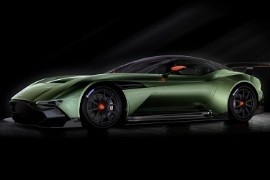
ASTON MARTIN Vulcan
Generations Timeline, Specs and Pictures

The British carmaker proved its value on the track with production models, and then it introduced the Vulcan as a track-only weapon.
Aston Martin did its homework on the race tracks, and its engineers learned how to transform a GT coupe into a class-winner. Aston Martin named the car Vulcan honoring the British Avro Vulcan strategic bomber. And when it did that, it had to build a remarkable track vehicle. Its customers were rich people or racing teams.
Since the Vulcan couldn’t be registered, the engineers had to worry only about the downforce and the mass distribution. The long hood that covered the V-12 underneath it featured two exhaust vents that extracted the radiator’s hot air. At the front, a narrow and wide grille followed the same design idea as any other Aston Martin’s grille from the DB2 onwards. From its sides, the low profile hypercar showed a curved sideline with a raised area above the rear fenders, while the greenhouse was tall enough to fit the race bucket-seats inside it. At the back, the carmaker installed a massive wing.
Inside, a cramped cockpit was designed for two seats, but usually, only one was installed during races. There was no CD radio or infotainment unit in it. Its windows were fixed. There were no airbags, and the so-called steering wheel was removable and contained the start button and the paddle-shifters.
Aston Martin built the Vulcan for races only. The carmaker installed a carbon-fiber torque tube and a carbon-fiber driveshaft to send the power to the rear wheels from the front-mid-mounted engine via a six-speed sequential gearbox. Last but not least, the Vulcan featured four hydraulic jacks that lifted the car from the ground to help the team changing the wheels.























































